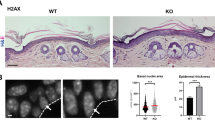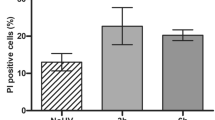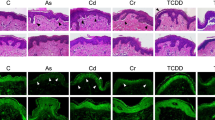Abstract
CARCINOGENIC polycyclic hydrocarbons have been shown to bind to DNA in mouse skin1–3, but no details are known of the conditions in which this binding occurs in vivo, for example the phase of the cell cycle, the functional status of DNA or whether the DNA is replicating or resting. Data are only available for in vitro binding to denatured and native DNA3,4. It could be assumed that replicating, histone-free DNA is a better target for hydrocarbons than resting DNA, in which case binding should be reduced if DNA synthesis is blocked. To test this idea we used hydroxyurea in different organisms5,6; this is a potent and rather specific inhibitor of DNA synthesis, and inhibits more than 90 per cent of DNA synthesis in mouse skin.
This is a preview of subscription content, access via your institution
Access options
Subscribe to this journal
Receive 51 print issues and online access
$199.00 per year
only $3.90 per issue
Buy this article
- Purchase on Springer Link
- Instant access to full article PDF
Prices may be subject to local taxes which are calculated during checkout
Similar content being viewed by others
References
Brookes, P., and Lawley, P. D., Nature, 202, 781 (1964).
Goshman, L. M., and Heidelberger, C., Cancer Res., 27, 1678 (1967).
Miller, E. C., Juhl, U., and Miller, J. A., Science, 153, 1125 (1966).
Poirier, L. A., Miller, J. A., Miller, E. C., and Sato, K., Cancer Res., 27, 1600 (1967).
Pollak, R. D., and Rosenkranz, H. S., Cancer Res., 27, 1214 (1967).
Kim, J. H., Gelbard, A. S., and Perez, A. G., Cancer Res., 27, 1301 (1967).
Wiest, W. G., and Heidelberger, C., Cancer Res., 13, 246 (1953).
Colburn, N. H., and Boutwell, R. K., Cancer Res., 26, 1701 (1966).
Doermer, P., Tulinius, H., and Oehlert, W., Z. f. Krebsforschg., 66, 11 (1964).
Elgjo, K., Epidermal Cell Population Kinetics in Chemically Induced Hyperplasia, Oslo, 36 (1966).
Brookes, P., Cancer Res., 26, 1994 (1966).
Heidelberger, C., J. Cell Comp. Physiol., 64 (suppl. 1), 129 (1964).
Frei, J. V., and Harsono, T., Cancer Res., 27, 1482 (1967).
Sachs, L., in Molekulare Biologie des Malignen Wachstums, 17, Coll Ges. Physiol. Chem. (edit. by Holzer, H.), 242 (Berlin, 1966).
Author information
Authors and Affiliations
Rights and permissions
About this article
Cite this article
SÜSS, R., MAURER, H. Reduced Binding of Carcinogenic Hydrocarbons to DNA of Mouse Skin during Inhibition of DNA Synthesis. Nature 217, 752–753 (1968). https://doi.org/10.1038/217752a0
Received:
Issue Date:
DOI: https://doi.org/10.1038/217752a0
This article is cited by
-
Action of hydroxyurea on chromosome physiology in Rhynchosciara angelae
Genetica (1978)
-
Possible influences of circadian rhythms in experimental carcinogenesis
Archives of Toxicology (1976)
-
Untersuchungen zur Synchronisation in vivo: Tempor�re Inhibition der DNA-Synthese durch Hydroxyharnstoff in normalen und malignen S�ugerzellsystemen
Zeitschrift f�r Krebsforschung und Klinische Onkologie (1971)
-
On the biochemical mechanism of tumorigenesis in mouse skin
Zeitschrift f�r Krebsforschung (1970)
-
Zum biochemischen Mechanismus der Tumorgenese der M�usehaut
Zeitschrift f�r Krebsforschung (1968)
Comments
By submitting a comment you agree to abide by our Terms and Community Guidelines. If you find something abusive or that does not comply with our terms or guidelines please flag it as inappropriate.



